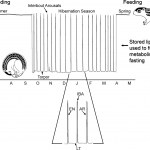neuron
Image from ProjectManhattan (Own work) [CC BY-SA 3.0 (http://creativecommons.org/licenses/by-sa/3.0)], via Wikimedia Commons
You probably already knew that fevers can cause some people to develop seizures. According to the National Institutes of Health, these so-called 'febrile seizures' can happen at temperatures of 102.2 degrees F and above and are most-often seen in children. The good news is that this type of seizure is usually short and does not often cause any long-term damage to the brain.
In a new study published in Physiological Reports, Researchers at Emory University (…
Birds get such a bad rap when it comes to intelligence. Sure they have relatively small brains, but scientists have known they are similar to primates with respect to their cognitive abilities. New research published in the Proceedings of the National Academy of Sciences presents data showing how this apparent dichotomy is possible. They found that the brains of songbirds and parrots pack two times the number of neurons as a primate of similar size. This means that these birds are able to pack neurons more tightly than mammals, which allows them to fit more brain cells in a smaller…
Image from the American Physiological Society's website.http://www.the-aps.org/mm/Conferences/APS-Conferences/2014-Conferences/…
Wednesday was the last day of the meeting that culminated in a closing banquet with an awards session to honor students who had exceptional presentations. What an impressive group of young comparative physiologists! The plenary lecture was given by Dr. Steven Chown (Monash Univ, Australia). He spoke about climate change forecasts and continuing environmental changes and how important it is to understand how animals adapt to changing conditions in order to…
Scientist Steven Wiederman from the University of Aukland (shown in image below) has recently published his work suggesting that dragonflies have the ability to focus on a target while blocking out other useless visual information. This is known as selective attention and his work is the first to demonstrate this ability in neurons from an invertebrate.
Sources:
Image Credit: David O'Carroll, University of Adelaide
Wiederman SA, O'Carroll DC. Selective attention in an insect visual neuron. Current Biology doi:10.1016/j.cub.2012.11.048
From the scientists who brought you the infamous 'Halle Berry neuron' and the 'Jennifer Aniston neuron' come the 'Oprah Winfrey neuron' and the 'Saddam Hussein neuron'.
Four years ago, Rodrigo Quian Quiroga from Leicester University showed that single neurons in the brain react selectively to the faces of specific people, including celebrities like Halle Berry, Jennifer Aniston and Bill Clinton. Now, he's back, describing single neurons that respond selectively to the concept of Saddam Hussein or Oprah Winfrey. This time, Quiroga has found that these neurons work across different senses,…
Say the word 'statistician' and most people might think of an intelligent but reclusive person, probably working in a darkened room and almost certainly wearing glasses. But a new study shows that a monkey in front of a monitor can make a reasonably good statistician too.
Tianming Yang and Michael Shadlen from the University of Washington found that rhesus macaques can perform simple statistical calculations, and even watched their neurons doing it. Psychologists often train animals to learn simple tasks, where the right choice earns them a reward and the wrong one leaves them empty-…
Since you've all been clamouring to see it, here's my new tattoo, and a video clip of the work in progress. It's an intrinsically photosensitive retinal ganglion cell, my favourite type of neuron. The artist was Gordon at Brain Drops, highly recommended. :)
Enjoy your holidays!
December 13 is my birthday! Yippee, you say, how old am I? Old enough to not say... I will shamelessly mention the Amazon wish list linked from my contact page, and remind you that Omni Brain has a tip jar in the sidebar (shared with Steve). But I'm not desperate for anything and there are plenty of deserving charities who need your money (I recommend UNIFEM). I'm thankful they are helping people in a more direct way than I can.
Anyway. I'm celebrating aging with a new tattoo, and am very excited about it! I've been interested in intrinsically photosensitive retinal ganglion cells (ipRGCs…
